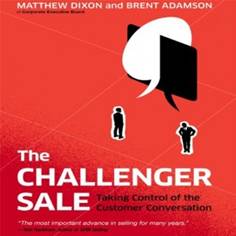A very popular sales book on the market right now is The Challenger Sale by Matthew Dixon and Brent Adamson. Its popularity is based on two things. First, the theories in the book are based on a very large data set - the actual performance of thousands of B2B  salespeople. Second, the theories break through traditional thinking about which type of salesperson performs best in a relatively complex selling environment.
salespeople. Second, the theories break through traditional thinking about which type of salesperson performs best in a relatively complex selling environment.
The objective of the “Challenger Study” was to identify what skills and behaviors are manifested by the elite salesperson – one who performs in the top 20% in his/her field. This article provides a summary of conclusions from The Challenger Sale book about what behaviors achieve the greatest success in a B2B environment.
5 Types of B2B Salespeople
According to the extensive study conducted for the book, B2B salesperson behaviors were organized into 5 types and defined as follows
Hard Workers – through sheer will, long hours and dedication, this type of salesperson is able to succeed
- Challengers – researches the customer and its competition, and focuses on building constructive tension to push the customer out of his/her comfort zone
- Relationship Builders – creates a strong personal relationship with the buyer and nurtures that relationship over time to maximize sales
- Lone Wolf – breaks most of the rules, goes his/her own way and typically achieves success through unconventional, individualized effort
- Reactive Problem Solver – focuses energy on identifying the customer’s current problem, then communicating how his/her product and/or service can solve it
The B2B Selling Environment has Changed
Dixon’s and Adamson’s studies indicate that the B2B buying decision process has experienced noticeable change in the last few years. The financial crisis that began in 2008 and ever-increasing competition in virtually every sector have caused these changes. In a nutshell, it’s less about relationships and loyalty, and more about economics and value. It’s less about continuing to do better at what you do, and more about being innovative and gaining a competitive advantage.
These dynamics have driven a change in how B2B decision makers view vendors and their products/services, and this has altered how suppliers sell their goods.
Which Type is Most Likely to be an Elite Salesperson
One of the most significant findings from the studies supporting The Challenger Sale is that the “Relationship Builder” sales style, thought to be the most effective, is actually the least likely style among elite salespeople. Dixon’s and Adamson’s studies of elite performers (top 20%) compared to core performers (middle 60%) resulted in the following summary
|
Sales Style |
% Elite – Those performing in top 20% in their respective firms |
% Core – Those performing in the middle 60% in their respective firms |
| Hard Worker |
16% |
22% |
| Challenger |
39% |
23% |
| Relationship Builder |
8% |
26% |
| Lone Wolf |
25% |
15% |
| Reactive Problem Solver |
12% |
14% |
Their studies revealed that only 8% of B2B salespeople practicing the “Relationship Builder” style were performing in the top 20% of their firm – the lowest among all the sales types. On the flip side, 39% of B2B salespeople practicing the “Challenger” style were performing in the top 20%. It is very important to remember that Dixon’s and Adamson’s studies were in B2B environments where the sales process is relatively complex - those dealing with multiple levels of an organization where average sale sizes are in the tens of thousands to multi-million dollars.
What Does a Challenger Do?
Here’s a brief summary of the “Challenger” style behaviors…
- Does extensive research into the customer and his/her competition
- Understands well the customer’s economic and value drivers
- Has a good understanding of how the customer conducts business
- Acts as a business consultant for the customer from the very beginning
- Creates constructive tension by pushing customer out of his/her comfort zone
- Offers unique and innovative perspectives
- Is skilled and comfortable discussing the customer’s sales, profits, economics, etc.
This all makes sense. Take the scenario of a “Relationship Builder” and one of his/her customers. A “Challenger” comes in and shares a unique perspective never before presented by a “Relationship Builder” and that perspective has a positive economic impact on the customer. That customer will no doubt pay close attention to what the “Challenger” has to say. Because of the critical nature of the economics, that customer will likely do one of two things: 1) go back to the “Relationship Builder” and ask why he/she hasn’t presented this type of solution, or 2) simply begin buying from the “Challenger”. Neither case is positive for the incumbent’s -the “Relationship Builder’s” - credibility and future success.
In summary, the world of B2B selling has changed, and the behaviors of the most elite salespeople have had to evolve to remain relevant, competitive and highly successful.





Agree, disagree, or just have something to add?
Leave a comment below.